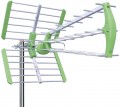Signal reception
Types of broadcasting for which the antenna is designed. Different types of broadcasting differ in the frequencies used and signal characteristics, which requires appropriate features in the antennas.
—
Analogue TV. Classic terrestrial broadcasting in analogue format. Due to the low quality of the signal and the tendency to interference, today it is considered completely obsolete, it is found mainly in those regions where DVB-T/T2 (see below) digital broadcasting has not yet been deployed. However, the requirements for antennas for analogue television broadcasting are no different from those for "digital" ones; therefore, almost all modern models, even those originally created for DVB-T/T2, work with an analogue signal without any problems.
—
DVB-T/T2. Digital terrestrial television, which replaced the analogue described above. Its main advantages are the ability to work with HD formats, as well as the fact that the quality does not depend on the signal level: either the viewer receives a full-fledged "picture" and sound, or they disappear completely (with a critical decrease in the signal level). Technically, DVB-T and DVB-T2 are different standards that are not compatible with each other; however, they have the same antenna requirements, so in this case, both types of broadcasting can be described together.
—
FM radio. The FM range (more
...precisely, the standard) is very popular among music radio stations due to the high quality of the transmitted sound, including stereo capabilities. FM broadcasting is carried out in the range of 87.5 – 108 MHz, which is not used in television broadcasting; therefore, for devices with FM tuners (TVs can also be equipped with such receivers), you should choose antennas in which compatibility with this range is directly stated.Amplification coefficient
The amount of received signal amplification provided by the antenna. The higher this indicator, the more confidently the antenna will work in conditions of poor reception, the lower the signal level at which it will be ineffective. At the same time, it is worth considering that a high amplification coefficient is not a guarantee of high quality. Firstly, unscrupulous manufacturers and sellers may indicate figures in the specifications that do not correspond to real indicators. Secondly, the antenna amplifies not only the useful signal, but also various interferences, and in some cases a low amplification coefficient is preferable (for example, in dense multi-storey buildings, when the signal reaches the antenna from different directions and with different delays). And thirdly, performance above 40 dB can only be achieved using amplifiers (see below) — and amplifiers are also a source of noise, which in some situations can be quite noticeable.
UHF frequency range
The frequencies of the UHF range for which the antenna is designed. UHF includes frequencies from 300 MHz to 3 GHz, however, frequencies above 900 MHz are practically not used in terrestrial television broadcasting, so TV antennas cover only the lower part of UHF. Also note that some manufacturers indicate a general range for their models, without dividing it into VHF (see above) and UHF; in such cases, this range is also indicated in this section.
Antenna sellers generally choose to sell models that are compatible with local frequencies. Therefore, in general, the frequency range is a rather specific parameter that the average user rarely needs — except when buying an antenna in another country.

